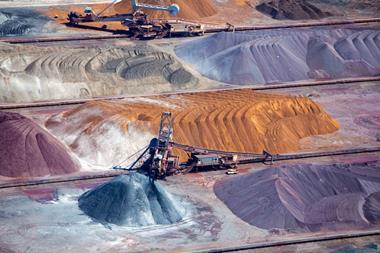Nina Röhrbein asks whether a wider application of ESG-type analysis would have helped mainstream investors in the sub-prime debacle
When markets nosedived this summer due to the US sub-prime crisis, few investors made a connection with ESG investing and analysis techniques. But could a look through an ESG lens have prevented the credit crunch, or at least minimised its effects for some market participants?
Those active in ESG or socially responsible investing point out that the mainstream financial world has certainly not yet made the connection. "Instead they started talking about credit rating agencies and what they have to take into account in the future," says Christian Werner, CIO at SAM (Sustainable Asset Management).
"It has not had much of an impact on the responsible investment industry as one would have thought," adds Rory Sullivan, head of investor responsibility at Insight Investment. "A lot of screened funds would not have invested in the banking sector to start with, so they would not have been affected by it. For other funds, sub-prime has widely been regarded as a mainstream investment issue rather than an issue that ESG specialists should have looked at,"
However, some felt an impact in the ESG industry. "Among some asset managers and research firms, the summer's credit crisis reinforced the idea that asset managers drive a little bit blind without some degree of ESG risk analysis, in particular in high-risk, high-return sectors like sub-prime," says Greg Larkin, senior analyst at strategic value advisors Innovest. "Furthermore, many ESG risks that have the biggest impact on asset performance are not included in the quant models that determine Wall Street risk appetites."
Innovest - which forecast the sub-prime crisis in the near-term in its Retail Lending Report in October 2006 - claims that far from hurting the ESG case, the sub-prime crisis should help practitioners and advocates in the area. Only from an ESG angle could the incipient risks be identified, says Innovest's CEO Matthew Kiernan.
"The sub-prime crisis was treated as a one-in-10,000-year event by most quant models," he says. "While everyone else was asking how to make more money in the booming US residential real estate market, we asked a fundamentally different question: whether the sub-prime sector loans benefited or hurt poor people. This gave us a fundamentally different perspective to everybody else caught up in the bull market.
"Our starting premise was to find how so many poor people could afford to buy their homes when the medium wage of Americans has remained completely stagnant since president George W Bush came to office. The answer we came up with is that they could in fact not afford these houses or repay the loans, which were non-transparent and designed to explode. And subsequently the security of the assets whose value is derived from those loans is financially not viable."
However, Sullivan points out that sub-prime lending may offer some important public benefits, through helping people who would otherwise be unable to get loans - whether because of a poor credit record or irregular earnings histories - to get on the housing ladder.
"The ethical issues around sub-prime are therefore not as clear-cut as they have been represented in the press," argues Sullivan. "Obviously there are issues around the terms under which money was lent and the assumptions being made about interest rates and the overall direction of the property market, but this should not necessarily mean that sub-prime lending is de facto a bad thing."
"Wall Street very much bases its research on quarterly results," says Larkin "However, a lot of environmental and social risks take around four or five years to materialise and do not show up in quarterly balance sheets or income statements. Now there is a realisation that you have to gather knowledge at the ground level about certain economic risks and asset valuations, which has to be incorporated into the quant model. But when we first issued the report - six months before the first cracks started to emerge in the sub-prime market - it fell on deaf ears."
He adds: "SRI research has historically been viewed as an option rather than a necessity. What sub-prime shows is that when ESG risk materialises, the entire economy can spiral downward. But you can really be in front of that trend as opposed to being caught out by surprise if you are evaluating the risks effectively."
With the ABX index, which tracks sub-prime securities, going up by another 15-20% for the next four months after its report was published, Innovest was going against the grain, says Larkin, despite widespread scepticism surounding the US housing bubble.
Werner says sub-prime's potential risk factor had been on the radar for as many as five years, but in particular after years of outstanding growth in this complex industry, finding the exact trigger point and timing of when it would strike was difficult.
"Most investors have been aware of the risks associated with sub-prime lending but clearly, the positioning of their portfolios would have depended on whether, when and at what scale they thought the sub-prime crisis would occur. So, the consequences for individual funds and fund managers would have to be examined on a case-by-case basis," says Sullivan.
Larkin puts the difficulty in predicting the sub-prime crisis down to a lack of precedent as the sub-prime sector did not exist until around 1996 and risk models are based on previously materialised factors.
But Sullivan is cautious about what ESG research can achieve. "The question is whether enhanced analysis is actually useful to investment managers and how it gets used by them," he says. "One of the big challenges is to understand the issues that are material to investment. Companies' corporate responsibility, which has been the prime focus of much of the ESG literature, may actually be quite irrelevant in a business where the really big issue is, for example, lending policy."
He also says that enhanced analysis may not actually be the holy grail that is often assumed in the responsible investment world. "Research on its own does not actually make investments any more responsible or ethical - it only means that people make more rational and well-informed decisions, and the outcome of those are not necessarily better for the environment or the public good. It is therefore essential that research is complemented by engagement to encourage companies to act in a responsible manner that takes proper account of both their investors and their wider stakeholders," he says. "The reality is that unethical practices can create longer-term liabilities."
Larkin admits a lot of SRI research is ethically astute but financially irrelevant. He says, it needs to look at ESG risk in a way that enhances returns, in particular as mainstream asset managers have an inherent mistrust of this type of research.
He believes that banks with good ESG policies, if they went into the sub-prime sector at all, made sure the loans were fixed rate, fully amortised and originated in the bank's own branches, which helps to survive a financial downturn. But he concedes that large-scale banks are often pressured into taking unsustainable risks for competitive reasons, while smaller banks can turn away from markets they do not view as viable from an ESG perspective.
"The limitations in enhanced analysis do not necessarily mean that screening is the answer," adds Sullivan. "Even those who screen need to deal with the ethical question of providing credit to people who are poor and struggle to get credit from conventional banks."
But what about ESG strategies - did they fare any better than their traditional counterparts over the summer? "Carbon credits were actually one of the most resilient sectors of the entire economy and one of the few that were untouched by credit contractions," says Larkin. "Mega-trends, such as more investment in renewables, drive growth in those assets, making them not entirely independent but somewhat shield them from crises like this.
"The flipside, however, is that the renewable energy and clean tech sector is going through a bit of a bubble, with very good companies and technology but very expensive stocks,"
"Every long-only equity product suffers when the market goes down. But when the market recovered, stocks like water, alternative energy and climate change recovered much faster than other stocks. So instead of seeing an outflow from our products during the summer, investors were actually looking for entry points during the market downturn," says Werner.












No comments yet